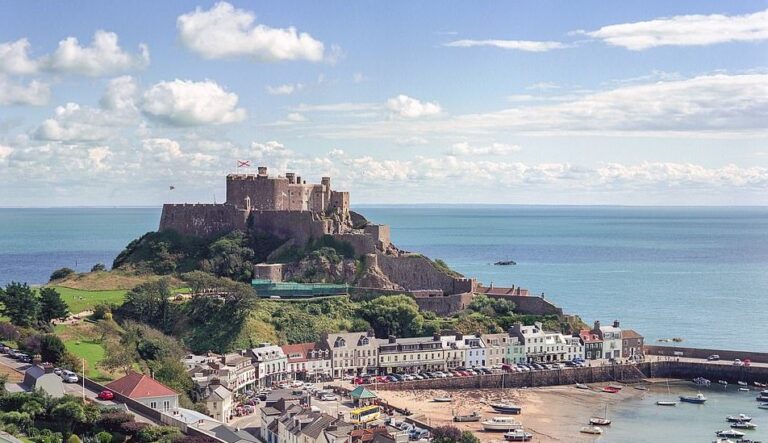You didn’t know that you wanted to go to Jersey? Neither did I, to be honest. But for at least the next few weeks, this pretty Channel Island, just a few miles off the northern coast of France, is your best option for an almost-foreign holiday, involving sun, sand, and some of the nicest people you could ever hope to meet. This is not an exaggeration. I was blown away by the good manners and natural warmth of the islanders.
With about the same population as Bath, Jersey is a tiny place, where everybody knows everybody. “That’s why we’re all so incredibly nice,” says Sean Kinsella, our good-natured kayaking guide. “You have to be or the island wouldn’t work.” As he leads me and my partner Georgia, both swaddled in our wetsuits, across the beach, he is greeted by a dozen locals. Soon after, we’re out at sea in our kayaks, gazing at the crazy spires of pink granite that rear out of the clear Atlantic, listening to the impossibly shrill cry of the oystercatchers overhead, and wishing we’d discovered Jersey years ago.
The reason the island is exempt from travel restrictions is it’s a British Crown Dependency, so it doesn’t count as abroad. Yet because it isn’t part of the UK, it makes its own rules. Here, unlike in the UK, you can eat inside restaurants. And if you’re from one of the majority of UK regions classed as COVID-safe, you can just fly in and take a free PCR test at the airport. Tony, the nurse who did my test, remarked that he liked my straw hat. I offered to swap it for his medical face shield, but he declined. This, however, was my first taste of Jersey charm. It’s not easy being likeable while swabbing someone’s nose.
The only catch to visiting the island is you have to isolate until your results come through by text, which takes up to 12 hours. In our case, it wasn’t so bad. Our berth at the swanky Atlantic Hotel had a balcony, so we watched the sunset while making the most of room-service.
The experience of spending time in Jersey is a bit like wandering into an advertisement for Werther’s Originals: the old-fashioned toffees whose sentimental branding includes images of grandfathers dandling cherubic toddlers. That’s how it feels as we drive slowly (the speed limit is 40mph) around the winding lanes of the island, past winsome, wisteria-clad cottages, while in the near-distance, the sunshine twinkles on the wind-stirred surface of the sea. It feels a lot like a nostalgic vision of how England might have looked about 75 years ago.
I ask a middle-aged English couple in our hotel, who are visiting Jersey for the third time, what draws them back. “Everyone’s so incredibly friendly,” the man replies. “It’s like stepping back in time,” his wife adds enthusiastically. It occurs to me to see if at some point I can buy an actual packet of Werther’s Originals to complete the mood — but as it turns out, more sophisticated culinary delights are in store. That evening, taking her first bite of the mind-blowing banana soufflé at Samphire restaurant in St Hellier, the island’s capital, Georgia emits a noise that is not unlike the call of an oystercatcher.
We’re both similarly excited the next day during lunch at Sumas on the island’s east coast. We sit out on the terrace, and the sun — more often seen on Jersey in 2020 than anywhere else on the British Isles — dutifully reappears. Nearby, across the bay, looms the castle of Mont Orgeuil. My rock oysters were sourced from one side of it. With a squeeze of lemon, they taste as fresh as a sea breeze. On the other side of the castle, we learn from Paul Dufty, Sumas’ suave owner, Georgia’s soft scallops were hand-picked by a diver. With a main of turbot, and a glass of crisp Spanish Albarino, it adds up to the best seafood lunch either of us has had in years.
I had no idea that Jersey was a foodie’s paradise. And there are other surprises, too, not the least of them the coldness of the sea, which almost gives me a heart attack when I take a dip from a beach on the east coast. It’s my turn to squeal like an oystercatcher.
Later, we learn that among the famous inhabitants of Jersey — as well as the society beauty Lillie Langtry and Superman actor Henry Cavill — was one Sir Walter Raleigh, who was governor of the island for three years at the start of the 17th century. The great adventurer came at a time when he was out of favour with good Queen Bess. His tobacco habit dismayed the islanders, who feared that smoking might be unhealthy. But they were grateful for the mighty castle he built on a rock in the bay at St Hellier. He called it Elizabeth Castle in the hope of flattering the queen, but sadly, she died soon afterwards, and her heir, James II, threw poor Raleigh back in the Tower of London.
We walk out to Raleigh’s castle at low tide over the damp sand, which is marked with the whorls of sand-worms, and marvel at its battlements. It’s wise not to stay long, though. On the shoulder of the Atlantic, the island has an immense tidal range. In a few hours, the place where we’re standing will be buried underwater. Back in St Hellier, we reward ourselves with a pint of Stinky Bay ale at the Prince of Wales pub. The place, populated by grizzled locals, is so old-school that it doesn’t accept cards. So we pay with cash, receiving our change in Jersey pounds.
Jersey has its attractions for the young. The surfing is supposedly second to none. Yet with the main remaining highlights being great food, spectacular coastal walks, and fascinating history, its appeal is perhaps more geared to an older demographic. I particularly enjoy the War Tunnels, an endless subterranean network built by the Nazis during their four-year occupation of the island. Designed as a hospital, and for sheltering troops in the event of an Allied attack, the place has been transformed into an unusual museum telling the story of what happened during that era. The personal stories — such as that of young June Sinclair, who slapped a Nazi soldier and got sent to a concentration camp — are extraordinarily moving.
The quaintness of Jersey is such that you might be tempted to wonder what lurks behind it. The answer, so far as I can tell from our too-brief stay, is nothing. Even the sinister-sounding Devil’s Hole, which we drop by on our way back to the airport, turns out to be just a large crater caused by coastal erosion. It’s pretty stunning, though, as is most of the steeply cliffed north coast.
Beside the path leading to the beauty spot is an enjoyably understated sign. It reads: “Devil’s Hole — well worth a visit”. Without hesitation, I’d say the same about Jersey. Go now, before a few other people have the same idea.

